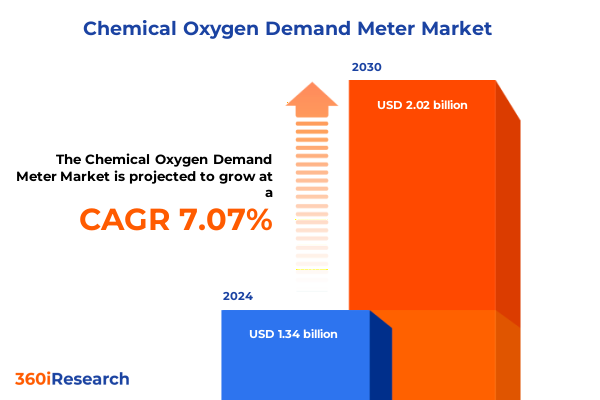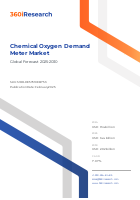The Chemical Oxygen Demand Meter Market size was estimated at USD 1.34 billion in 2024 and expected to reach USD 1.44 billion in 2025, at a CAGR 7.07% to reach USD 2.02 billion by 2030.

Introduction
The Chemical Oxygen Demand (COD) meter market is at a pivotal juncture as stakeholders seek tools that deliver precise, reliable, and rapid assessments of organic pollution in environmental and industrial matrices. COD measurement stands as a critical parameter for water quality analysis, guiding decisions that impact ecological health, regulatory compliance, and operational efficiency across aquaculture, chemical processing, food and beverage, and municipal treatment facilities. As regulations tighten globally and technology advances, decision-makers require an authoritative overview of emerging trends, transformative innovations, and strategic imperatives that will shape the trajectory of COD instrumentation.
This executive summary provides a holistic perspective on the forces driving the COD meter landscape, emphasizing the convergence of regulatory pressures, technological breakthroughs, and market dynamics. By examining shifts in analytical techniques, assessing the implications of landmark trade policies, and identifying key segmentation, regional, and competitive insights, this narrative equips experts and decision-makers with actionable intelligence. The aim is to foster informed strategies that capitalize on emerging opportunities, mitigate risks, and ensure optimal investment in COD measurement solutions for sustained environmental stewardship and operational excellence.
Transformative Shifts in the Landscape
The COD meter industry has undergone profound shifts, driven by the integration of advanced electrochemical techniques and digital analytics. Potentiometric platforms have evolved from single-channel detectors to versatile multi-channel systems that streamline high-throughput testing, while voltammetric approaches now leverage cyclic, differential pulse, and linear sweep methods to enhance sensitivity and selectivity. Concurrently, closed reflux analyzers have transitioned from semi-automatic workflows to fully automatic configurations, reducing manual intervention and boosting laboratory throughput.
Digital connectivity has further transformed the landscape: modern instruments embed smart sensors, wireless protocols, and cloud-based data management to deliver real-time insights and predictive maintenance alerts. This fusion of hardware and software not only accelerates decision-making but also aligns with the Industry 4.0 paradigm by facilitating remote monitoring and integration with broader environmental management systems. Moreover, the rise of portable, rechargeable COD meters has empowered field technicians to conduct on-site analyses without the constraints of benchtop laboratory setups, reinforcing the trend toward decentralized testing.
Cumulative Impact of United States Tariffs 2025
The introduction of new tariffs in 2025 has introduced both challenges and opportunities for suppliers and end-users of COD meters. By raising duties on key components and finished instruments, the measures have increased the cost of imported analyzers, particularly impacting manufacturers that rely on global supply chains for precision sensors and microelectronic modules. This escalation in landed costs has prompted some vendors to localize production or seek tariff-exempt certifications under revised trade agreements.
Conversely, domestic producers have leveraged these changes to strengthen market presence, investing in capacity expansion and R&D to deliver competitive alternatives. End-users have responded by prioritizing total cost of ownership evaluations over sticker prices, recognizing that advanced features such as multi-analyte capability and automated calibration can offset higher initial expenditures. In parallel, service providers have tailored maintenance contracts to accommodate longer equipment lifecycles, thereby mitigating budgetary pressures arising from the tariff-driven cost increases.
Key Segmentation Insights
A nuanced understanding of market segmentation reveals distinct growth vectors for different COD meter categories. In the domain of technology, potentiometric instruments split into multi-channel and single-channel offerings cater respectively to high-throughput analytical laboratories and budget-constrained facilities requiring straightforward measurements. Voltammetric solutions differentiating cyclic voltammetry from differential pulse and linear sweep techniques provide heightened analytical granularity, essential for research institutions probing complex organic matrices.
When examining applications, fish farms and shellfish farms within aquaculture demand portable meters for rapid on-site testing, while basic, bulk, and specialty chemical producers rely on benchtop configurations to ensure compliance with stringent process controls. Environmental monitoring divides into groundwater, ocean water, and surface water assessments, each necessitating tailored sensor chemistries. In food and beverage, beverage processing, dairy processing, and meat processing operations adopt COD meters to verify product quality and effluent standards. Wastewater treatment stakeholders in agricultural, industrial, and municipal sectors employ different calibration protocols to align with varied contaminant profiles.
End-user segmentation highlights that industrial clients in construction, manufacturing, and mining prefer rugged analyzers with minimal maintenance demands; consulting firms and private laboratories focus on high-precision portable and benchtop devices; municipalities and research institutions in the public sector seek instruments validated against ASTM D1252-06, EPA Dichromate Method, and ISO 6060 standards.
With respect to product type, benchtop systems offer non-touch screen and touch screen interfaces to fit laboratory ergonomics, whereas battery-operated and rechargeable portable units support field deployments. Material analysis categories reveal that soluble inorganic and organic compounds in liquids, gel and paste matrices in semi-solids, and sediment and sludge solids each require specific digestion procedures. Finally, analyzer methods split between closed and open reflux protocols, with fully automatic closed reflux solutions delivering the highest throughput. Adherence to industry standards-ASTM D1252-06, EPA Dichromate Method, and ISO 6060-remains a critical decision factor for buyers who must demonstrate compliance in regulated environments.
This comprehensive research report categorizes the Chemical Oxygen Demand Meter market into clearly defined segments, providing a detailed analysis of emerging trends and precise revenue forecasts to support strategic decision-making.
- Technology
- Application
- End-User
- Product Type
- Material Analyzed
- Analyzer Method
- Industry Standards
Key Regional Insights
Regional dynamics play a pivotal role in shaping COD meter demand. In the Americas, stringent federal and state regulations incentivize the adoption of advanced analyzers, particularly in wastewater treatment and chemical manufacturing hubs. Corporate sustainability initiatives in North America underscore investments in high-accuracy potentiometric and voltammetric platforms, while emerging economies in Latin America prioritize cost-effective portable meters to address decentralized environmental monitoring needs.
Europe, the Middle East & Africa exhibit a diverse regulatory landscape, with the European Union’s Water Framework Directive driving demand for benchtop systems in surface water analysis, and Gulf Cooperation Council nations investing in desalination and wastewater reuse projects that require robust, corrosion-resistant analyzers. Africa’s growing industrial sector and expanding aquaculture operations have begun to adopt portable COD meters, leveraging rechargeable battery technology to overcome infrastructure constraints.
In Asia-Pacific, rapid urbanization and industrial expansion in countries such as China, India, and Australia fuel demand for automated closed reflux systems that support high-volume testing in municipal and industrial treatment plants. At the same time, research institutions and private laboratories in Japan and South Korea increasingly deploy voltammetric methods for specialized environmental studies, reflecting a preference for precision and methodological versatility.
This comprehensive research report examines key regions that drive the evolution of the Chemical Oxygen Demand Meter market, offering deep insights into regional trends, growth factors, and industry developments that are influencing market performance.
- Americas
- Asia-Pacific
- Europe, Middle East & Africa
Key Companies Insights
The competitive landscape features established instrumentation leaders and innovative niche players. Analytik Jena GmbH + Co. KG and Metrohm AG anchor the high-precision benchtop segment, while Hach Company and Thermo Fisher Scientific Inc. command broad portfolios across portable and laboratory-grade COD meters. Endress+Hauser Group Services AG and Shimadzu Corp. differentiate through integrated process analytics solutions, and YSI Inc. by ITT Corp. leverages battery-operated platforms for field monitoring.
CamLab Water, Contech Instruments Ltd., and Infitek Co., Ltd. focus on specialized regional markets, offering tailored service networks. DKK-TOA Corporation and Geneq Inc. emphasize versatility by combining potentiometric and voltammetric capabilities. Manufacturers such as Mettler Toledo and Horiba, Ltd. integrate touch screen and non-touch screen interfaces in benchtop systems, while Palintest Ltd. and Realtech by ABB Ltd. excel in portable, rechargeable instrument designs. DTK Water and VELP Scientifica Srl address semi-solid and solid sample matrices, and LaMotte Company, Lovibond, Metrohm AG, and Shanghai Boqu Instrument Co., Ltd. reinforce compliance focus through ASTM, EPA, and ISO-certified analyzers. Rok International, ShangHai INESA Scientific Instrument Co., Ltd., and Hanna Instruments Ltd. offer cost-effective solutions optimized for emerging markets.
This comprehensive research report delivers an in-depth overview of the principal market players in the Chemical Oxygen Demand Meter market, evaluating their market share, strategic initiatives, and competitive positioning to illuminate the factors shaping the competitive landscape.
- Analytik Jena GmbH+Co. KG
- Camlab Water
- Contech Instruments Ltd.
- DKK-TOA Corporation
- DTK Water
- Endress+Hauser Group Services AG
- Geneq Inc.
- Hach Company
- Hanna Instruments Ltd.
- Horiba, Ltd.
- Infitek Co., Ltd.
- LaMotte Company
- Lovibond
- Metrohm AG
- Mettler Toledo
- Palintest Ltd.
- Realtech by ABB Ltd.
- Rok International
- Shangai INESA Scientific Instrument Co.,Ltd.
- Shanghai Boqu Instrument Co., Ltd.
- Shimazdu Corp.
- Thermo Fisher Scientific Inc.
- VELP Scientifica Srl
- Xylem Inc.
- YSI Inc. by ITT Corp.
Actionable Recommendations for Industry Leaders
Industry leaders should pursue a multi-pronged strategy that balances innovation with operational resilience. First, expanding R&D efforts in voltammetric and closed reflux automation will capture demand for higher-precision and high-throughput applications. Second, investing in modular instrument architectures and cloud-enabled analytics platforms will address the growing need for scalable solutions that integrate seamlessly into digital ecosystems.
Third, cultivating local manufacturing and distribution partnerships can mitigate tariff impacts and shorten supply chains, enhancing responsiveness to regional regulatory changes. Fourth, developing flexible financing and service models-such as subscription-based instruments and performance-based maintenance contracts-will appeal to budget-constrained municipal and private laboratories. Fifth, reinforcing cybersecurity protocols and data integrity features will build customer trust as remote monitoring and digital data exchange become standard in environmental analytics.
Explore AI-driven insights for the Chemical Oxygen Demand Meter market with ResearchAI on our online platform, providing deeper, data-backed market analysis.
Ask ResearchAI anything
World's First Innovative Al for Market Research
Conclusion
The COD meter market stands at the intersection of environmental accountability, technological innovation, and evolving trade policies. Stakeholders who integrate advanced analytical techniques, digital connectivity, and strategic regional positioning will secure competitive advantages. Embracing modular, automated platforms that comply with international standards ensures both regulatory alignment and operational efficiency. As end-users prioritize total cost of ownership and data integrity, vendors that deliver comprehensive solutions-from rugged portable meters to high-throughput benchtop analyzers-will lead the next phase of market expansion.
This section provides a structured overview of the report, outlining key chapters and topics covered for easy reference in our Chemical Oxygen Demand Meter market comprehensive research report.
- Preface
- Research Methodology
- Executive Summary
- Market Overview
- Market Dynamics
- Market Insights
- Cumulative Impact of United States Tariffs 2025
- Chemical Oxygen Demand Meter Market, by Technology
- Chemical Oxygen Demand Meter Market, by Application
- Chemical Oxygen Demand Meter Market, by End-User
- Chemical Oxygen Demand Meter Market, by Product Type
- Chemical Oxygen Demand Meter Market, by Material Analyzed
- Chemical Oxygen Demand Meter Market, by Analyzer Method
- Chemical Oxygen Demand Meter Market, by Industry Standards
- Americas Chemical Oxygen Demand Meter Market
- Asia-Pacific Chemical Oxygen Demand Meter Market
- Europe, Middle East & Africa Chemical Oxygen Demand Meter Market
- Competitive Landscape
- ResearchAI
- ResearchStatistics
- ResearchContacts
- ResearchArticles
- Appendix
- List of Figures [Total: 30]
- List of Tables [Total: 1164 ]
Call-to-Action (CTA) with Ketan Rohom (Associate Director, Sales & Marketing) to Purchase the Report
To gain a deeper understanding of these market dynamics and access detailed analyses of segmentation, regional trends, and competitive benchmarking, connect with Ketan Rohom, Associate Director, Sales & Marketing. Engage directly to secure your copy of the full market research report and position your organization at the forefront of COD meter innovation and strategy.

- How big is the Chemical Oxygen Demand Meter Market?
- What is the Chemical Oxygen Demand Meter Market growth?
- When do I get the report?
- In what format does this report get delivered to me?
- How long has 360iResearch been around?
- What if I have a question about your reports?
- Can I share this report with my team?
- Can I use your research in my presentation?




